Preparing radishes for the winter: simple and tasty recipes for healthy snacks
Radishes are valued as an early vegetable. Get your first greenhouse harvest radishes possible as early as April. To preserve the vegetable for as long as possible, root vegetables are pickled, salted, canned and frozen.
Today there are a large number of ways to prepare radishes for the winter. In the article we will discuss how to select and prepare radishes, and also consider recipes for salting in a jar, pickling, and other preparation methods.
Which radish is suitable for winter preparations?
For preservation, large fruits with a diameter of 2.5 cm, covered with thin skin are usually used. The color of root vegetables can be different: pink, white, red, purple. They also differ in shape: from flat-rounded to spindle-shaped. The standard option is the variety Anabel F1, Zlata, Champion, Politez, Molniya F1.
To preserve vegetables for the winter, it is better to choose varieties with a medium or late ripening period. They are more tasty and last longer. These include the variety Red Giant, Zlata, Cherriet. The choice of variety also depends on the characteristics of the recipe.
If it is necessary to harvest whole root crops, you should choose varieties with an even, regular shape. If you need to chop a vegetable, preference is given to large-sized fruits with juicy pulp.
Advice. When purchasing radishes, pay attention to their appearance: the root vegetables must be intact, without signs of spoilage, and firm to the touch.
The quality of the fruit is affected by proper harvesting. It is important to remove the green leaves within five hours of digging.Otherwise, the pulp becomes watery.
Fruit preparation
Remove leaves and stems from root vegetables and rinse several times with running water. Gently remove dried dirt using a dishwashing sponge. If the root vegetables are limp and soft to the touch, it is recommended to soak them in cold water for one hour.
How to prepare radishes for the winter in jars - the best recipes
There are many different recipes for preparing radishes for the winter. Due to the wide variety of options, everyone will find a recipe based on their taste preferences. Below we will look at the classic method of preserving radishes, and for those who like the original, a recipe for radishes with red currants and salted radishes with tops.
Canned radishes with vinegar and herbs
Ingredients for 5 servings:
- radishes - 0.5 kg;
- fresh dill;
- green onion;
- black peppercorns and fragrant 3-4 pieces each;
- bay leaf;
- cloves - 2 pcs.
Marinade:
- water - 50 ml;
- salt - 2 tsp;
- sugar - 4 tsp;
- table vinegar 9% - 50 ml;
- vegetable oil - 2 tbsp.
Recipe:
- Remove tops and tails from radishes and rinse well with water.
- Cut large root vegetables into halves or quarters.
- Wash the greens and dry on a paper towel. Remove the green feathers from the onion; they will not be needed.
- Finely chop the dill and the fleshy white stalk of the onion.
- Alternately place a layer of radishes and a layer of green onions on the bottom of sterilized jars. Place whole sprigs of dill and parsley on top.
- Place black peppercorns, allspice, bay leaf, cloves in jars, add vegetable oil.
- Prepare a marinade from water, sugar, and salt and bring to a boil. Finally, add vinegar and boil again.
- Pour the hot marinade over the radishes. Close the jars with sterilized lids.
- Place a special stand for sterilizing jars at the bottom of the pan or cover it with a towel folded in several layers. Lower the jars and fill the pan with hot water to the level of the jars' hangers. Sterilize for 7-10 minutes.
- Turn the jars upside down, wrap them in a warm blanket, and leave for 1-2 days until completely cooled.
- Store in a cool, dark place, possibly in the refrigerator.
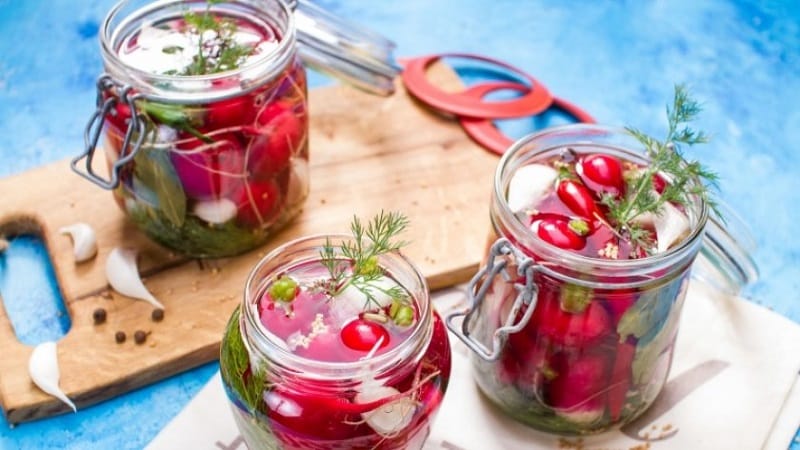
Korean radishes for the winter
Ingredients:
- radishes - 0.5 kg;
- green onions - 1-2 bunches;
- garlic - 3-4 cloves;
- 1 pod hot pepper;
- salt - 100-150 g.
Cooking method:
- Wash the radishes, remove leaves and stems. Cut the root vegetables into circles or slices. If desired, you can add finely chopped tops. The leaves will add piquancy to the preparation and improve the taste.
- Wash the pepper, remove the seeds, chop finely.
- Grind the peeled garlic using a press or chop it finely. Mix with hot pepper.
- Pour the radishes into a dry, clean container, add the garlic-pepper mixture, and add salt. Mix everything well, you can even use your hands - this way the root vegetables will be evenly salted and the juice will release faster.
- Next, add finely chopped green onions to the vegetables. Use both the green feathers and the white fleshy part. Mix everything well again.
- Place radishes tightly in sterile jars. Close full jars with sterilized metal lids.
- The jars should stand for 1-2 days at room temperature, then put them in a cold room.
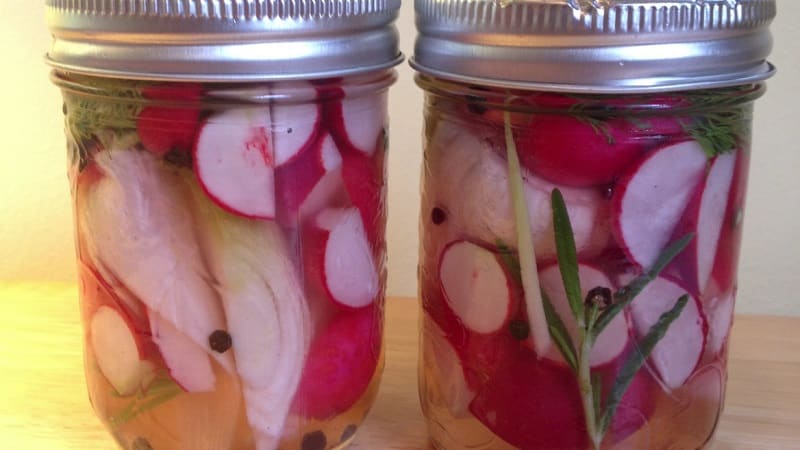
Salted radish with tops
Ingredients:
- radishes - 700-1000 g;
- green onions;
- half a red hot pepper;
- garlic - 2-4 cloves;
- salt to taste.
Recipe for salting in a jar:
- Wash the radishes well and remove the stems. Do not cut the tops. Cut large root vegetables in half.
- Coarsely chop the green onions.It is better to choose a plant with large green feathers, as they are more fragrant.
- Prepare a dressing from chopped garlic and ground red hot pepper.
- In a separate bowl, mix onions and radishes. Add salt and mix everything well again. Season with spicy mixture.
- Leave for 30-60 minutes. Next, place in clean, sterile jars and cover with a plastic lid. Leave it warm. After three days, put the jars in a cool place, maybe in the refrigerator.
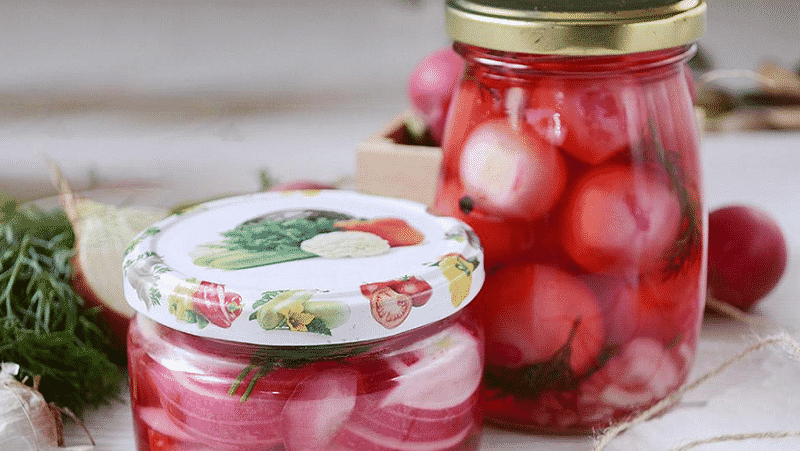
Lightly salted radish
Products:
- radishes - 0.5 kg;
- sugar - 2 tbsp;
- table vinegar 9% - 2 tbsp;
- salt - 2 tbsp;
- water - 50 ml.
Recipe:
- Wash the root vegetables, remove the stems, peel them. Cut into 4 parts.
- Mix sugar, salt, vinegar, water in a container. Pour cold brine over the radishes and mix everything well.
- Place the vegetables in the refrigerator overnight. Next, place in sterile jars and close with metal lids.
- Store in a cool, well-ventilated area.
Recipe with red currants
Ingredients for two 0.5 liter jars:
- radishes - 1.5 kg;
- red currant - 100 g;
- onion - 0.5 kg;
- water - 1 l;
- salt - 2 tbsp;
- sunflower oil - 150 g;
- black pepper peas - 5 pcs.
How to cook:
- Remove stems and leaves from radishes and rinse. Place chopped onions at the bottom of sterilized jars and root vegetables on top.
- Separate the currant berries from the branches, rinse, and grind through a sieve.
- Prepare a marinade from water, salt and currant juice with pulp. Boil.
- Separately, heat the sunflower oil, pour 75 ml into each jar.
- Next, pour hot brine over the radishes.
- Prepare the pan for sterilization: place a special device for jars on the bottom or lay a towel folded in several layers.Lower the cans. Pour hot water into the pan up to the level of the hangers of the jars. Sterilize after boiling for 15 minutes.
- Close with metal lids. Turn the jars upside down, wrap them, leave for 1-2 days until completely cooled.
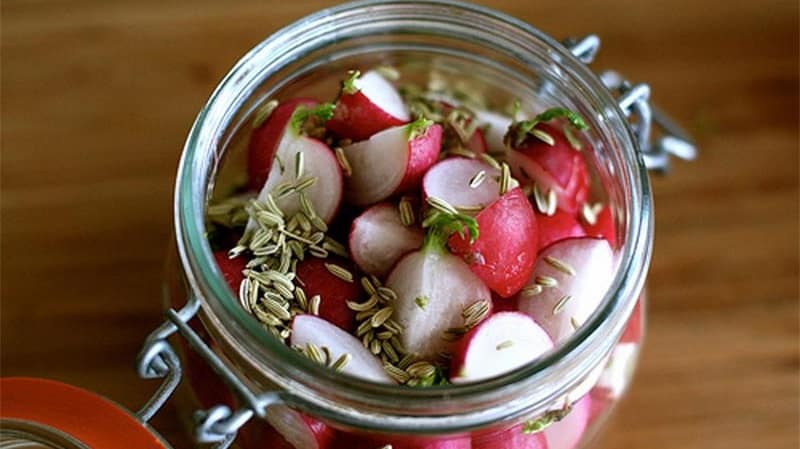
Pickled radishes with aspirin
Products:
- radishes - 250 g;
- salt - 1 tsp;
- sugar - ½ tsp;
- water - 250 ml;
- vinegar - 50 g;
- dill greens;
- "Aspirin" - 1 tablet.
Recipe:
- Wash the root vegetables, remove the stems.
- Sterilize the jars in a convenient way, spread out the radishes.
- Boil water, pour in radishes. Leave for 15 minutes.
- Pour the water back into the pan, add salt, sugar, and boil everything again. Finally, add vinegar and bring to a boil again.
- Place whole sprigs of dill on top of the jars, you can cut them. Pour boiling marinade, add one aspirin tablet, close with sterilized metal lids.
- Turn the jars upside down and wrap them in a warm blanket for 1-2 days. Store the preparations in a cellar or pantry.

Recipe with onions and garlic
Ingredients:
- radish - 0.5 kg;
- onions - 250 g;
- garlic - 4-5 cloves;
- bay leaf - 2 pcs.;
- black peppercorns - 5-6 pcs.;
- dill.
Brine:
- water - 500 ml;
- salt - 15 g;
- table vinegar 9% - 35 g.
Recipe:
- Wash the radishes, cut off the tails, chop them into slices 7-10 mm thick.
- Peel the onion and garlic, rinse and cut into slices.
- Place onions and garlic at the bottom of sterilized jars, then radishes, and dill sprigs on top.
- Pour boiling water over the preparations, leave for 5-10 minutes, pour the water into a saucepan.
- Add salt, sugar, spices to the water, and after boiling, pour in vinegar.
- Fill the jars with hot brine and close with sterilized metal lids.
- Turn it over and wrap it in a warm blanket.When the jars have cooled completely, place them in the cellar.

How to preserve jars correctly
To extend the shelf life of canned goods and preserve their taste, it is important to follow standard recommendations on how to properly preserve radishes for the winter:
- Choose root vegetables of the same size, fresh, without signs of spoilage, and elastic to the touch.
- Wash the radishes thoroughly before cooking. To remove dried dirt, soak root vegetables in cold water for half an hour.
- Prepare jars and lids. Inspect the dishes for damage. Cans with chips should not be used. The lids must be straight and not bent.
- To check the jar for leaks, fill it with water and shake. If the water does not pour out, it means the jar is closed tightly.
- Wash the jars thoroughly with soda or mustard powder to remove germs. It is better to use a new sterile sponge.
- Sterilize jars and lids in a convenient way. The best option is an oven. Quite a lot of cans can be placed at one time. You can put the lids on right away.
- Place vegetables in dry jars. Can be filled up to the hanger or under the lid. The last option is better, since the less air, the lower the likelihood of oxidation and fermentation.
- After sealing the jar, turn it upside down and see if the contents leak out.
- The workpieces should cool gradually. To do this, turn the jars upside down, wrap them in a warm blanket, and leave for 1-2 days.
Store the workpieces in a cool, dark, well-ventilated area. The ideal option is a cellar. Some preparations can be stored in the refrigerator.
For reference. The shelf life of the preserved product is 24 months. But it is better to eat the preparations before the next harvest season.
Workpieces with and without sterilization
Sterilization of jars is carried out thermally in order to destroy microbes, bacteria, and spores. Thanks to this process, the workpieces are better preserved, the likelihood of oxidation and mold formation is practically reduced to zero.
How to properly sterilize jars with blanks:
- Place a special device in a saucepan with a wide bottom for fixing jars during sterilization or cover with a towel (other fabric) folded in several layers.
- Carefully place the hot filled jars into the pan. You can also put matter between them. Cover with lids, but do not tighten.
- Pour hot water into the pan up to the hangers of the jars.
- After boiling, sterilize half-liter jars for 7-10 minutes and liter jars for 10-20 minutes.
- Next, remove the hot jars from the water and seal them.
If the recipe does not provide for sterilization, then be sure to fill the jars with boiling brine and immediately close them with metal lids using a seaming wrench or screw caps. Jars and lids must be pre-sterilized.
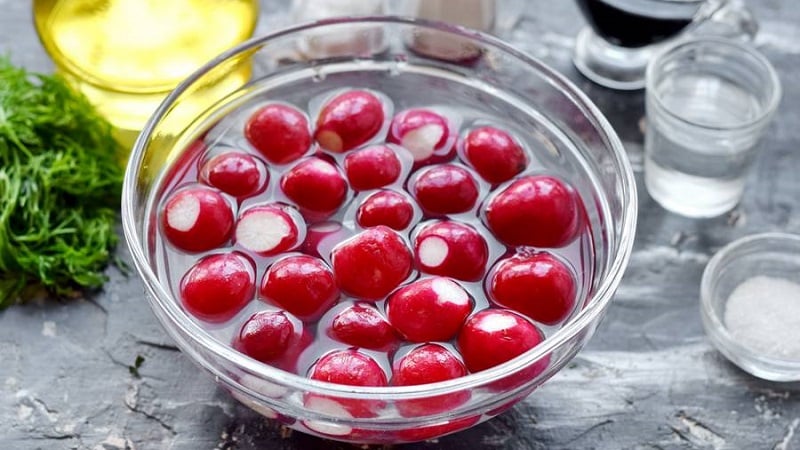
Preparing by freezing
For freezing, you should select whole, elastic root vegetables, preferably of the same size. Cut off the tails and leaves of the radishes, rinse well, and remove any remaining water with a paper towel. Cut large root vegetables in half or into quarters.
Further, so that water does not release from the radishes during storage, which will turn into ice, freezing should begin at low temperatures. Place the root vegetables in the freezer for 10-15 minutes at a temperature of minus 30-40 degrees. Then package it in special bags for freezing and store it in the freezer at a temperature of -6 to -24 degrees. Shelf life: 12 months.
Conclusion
Now you know the most popular and easy-to-prepare recipes for preparing radishes for the winter. This vegetable is a universal food product that can be eaten fresh, canned, salted, pickled, or frozen.
Follow the simple rules for preparing it, and then your family members will appreciate its excellent taste.